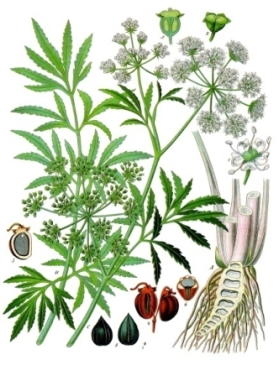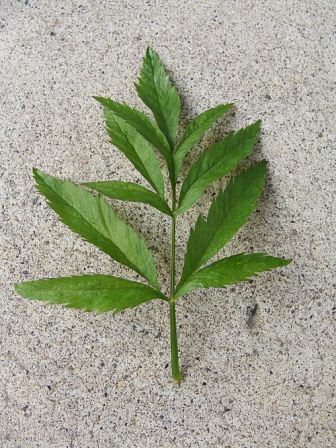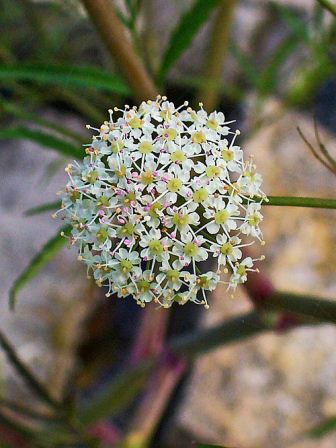Water Hemlock
A Deadly Poisonous Plant

Water hemlock (Cicuta spp.) is one of the most deadly poisonous plants in North America. When you begin learning about wild plants, a great place to start is with the most dangerous species found in your area. This way you can be sure to avoid these poisonous plants when out in the field learning about other species.
Caution: Water hemlock can be deadly. It contains a toxin called cicutoxin, a violent convulsant, which acts as a stimulant in the central nervous system. Ingestion of hemlock can be fatal and symptoms can occur 15 minutes to 6 hours after the plant has been ingested.
Initial symptoms may include the rapid onset of seizure activity along with nausea, vomiting, muscle twitch, increased pulse, excessive salivation or frothing at the mouth, and dilation of the pupils. Deaths usually occur from respiratory paralysis a few hours after ingestion.

Identifying Water Hemlock
Description: A perennial plant that grows to a height of 3 to 7 feet tall. The leaves are up to 15 inches long, alternately-arranged, and tri-pinnately-compound (divided into leaflets three times) with numerous 2 to 5 inch ovate leaflets. They are also sharply toothed. The leaf veins terminate at the bottom of leaf serrations and not at the tips, which helps to identify this plant.

Flowers are white and tiny, have 5 petals that grow in umbrella-like clusters 2 to 8 inches across. The plant flowers in spring or early summer. The stem is smooth, hollow, and often has purplish-green striations. It has a tuberous root with rootstalks that are multi-chambered and contain a yellowish oily liquid. This poisonous liquid can smell like raw parsnip.
Types of Water Hemlocks: bulblet-bearing w. h. (Cicuta bulbifera) , western w. h. (Cicuta douglasii), beaver poison (Cicuta maculata), cowbane (Cicuta virosa), spotted w. h. (Cicuta occidentalis)
Other Common Names: Spotted cowbane, muskrat weed
Family:: Apiaceae (formerly Umbelliferae) - commonly known as carrot or parsley family
Be More Prepared For Your Next Outdoor Adventure!

Don't leave home without knowing these six essential survival skills. Our free survival mini guide reveals the strategies of:
- Shelter & fire to prevent the number one cause of death
- Obtaining clean water to avoid life-threatening dehydration
- Common wild survival foods and other critical skills!

Habitat and Range: Typically a wetland plant, common on pastures or tilled areas. This plant occurs in wet, fertile soils at the edge of waters, along streams, and irrigation canals. It is most common in deep loam, clay loam, or clay soils. These hemlock species are found throughout North America and Europe.
Similar species: Poison hemlock (Conium maculatum) is sometimes confused with the water hemlock. Differences are in the root and leaf structure - poison hemlock has a single tap root and the leaf veins run through to the tips of the leaf serrations.
Water parsnip (Sium suave) like hemlock grows in similar habitat near water edges. Both have clusters of white flowers, but water parsnip has bracts (leaf like structures) at the base of flowers and the main flower head, where water hemlock only has bracts at the base of each small flower cluster. Another way to differentiate water parsnip from hemlock is that its leaves are once compound (divided) whereas water hemlock's leaves are three times compound.
Yarrow (Archillea millefolium) has a similar flower structure as compared to water hemlock, however yarrow's leaves and stem have a hairy appearance. Hemlock's leaves and stem are smooth.
Other: Historically, it is said that some Native American tribes once used hemlock to poison tips of arrows for hunting purposes.
References:
Water Hemlock - USDA
Lacy White Flowers: The Good, the Bad and the Deadly
Related Courses:
Wild Edible & Medicinal Plants Courses at Alderleaf
By the way, when you're out foraging, it's important to know how to stay safe in the outdoors, especially if you were to get lost. Right now you can get a free copy of our mini survival guide here, where you'll discover six key strategies for outdoor emergencies, plus often-overlooked survival tips.

About the Author: Michelle Peziol is a Wildlife Track & Sign Evaluator with CyberTracker Conservation. She wrote articles while teaching at Alderleaf. Learn more about Michelle Peziol.
Return from Water Hemlock back to Wild Plants Articles
Is The Essential Wilderness Survival Skills Course Right for You? Take the "Online Survival Training Readiness" Quiz
See for yourself if this eye-opening course is a good fit for you. It takes just a few minutes! Get your Survival Training Readiness Score Now!

Grow Your Outdoor Skills! Get monthly updates on new wilderness skills, upcoming courses, and special opportunities. Join the free Alderleaf eNews and as a welcome gift you'll get a copy of our Mini Survival Guide.

 The Six Keys to Survival: Get a free copy of our survival mini-guide and monthly tips!
The Six Keys to Survival: Get a free copy of our survival mini-guide and monthly tips!
Learn more